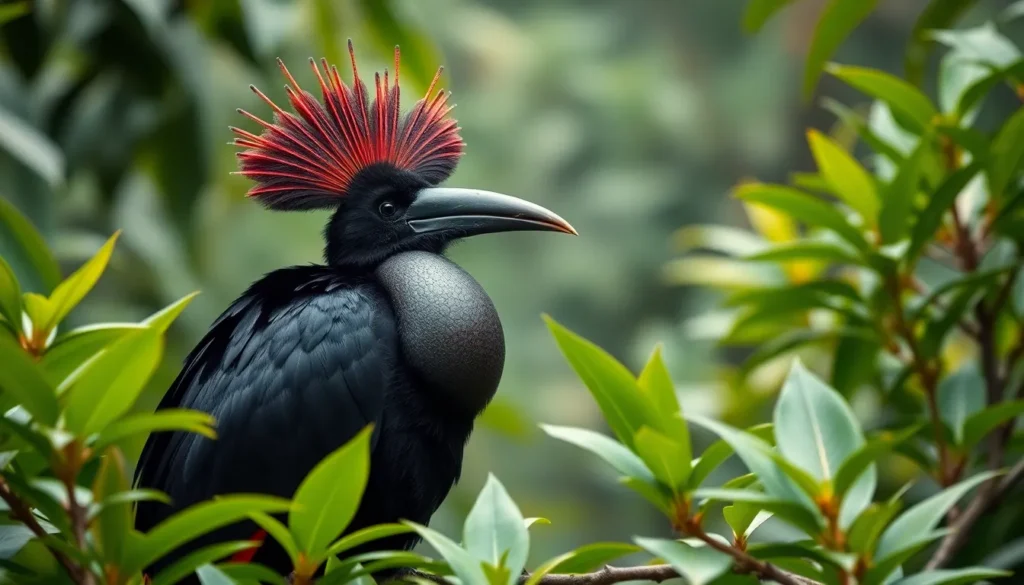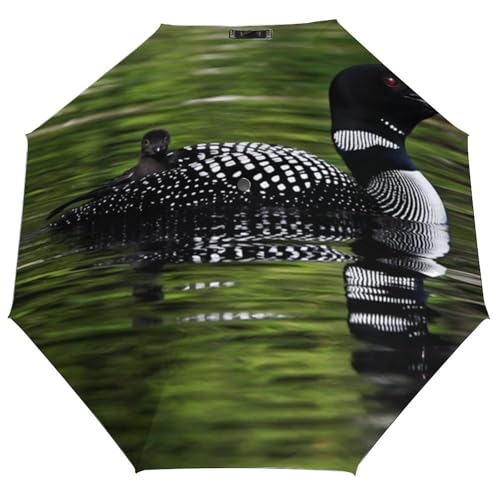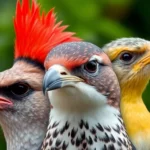Deep in the misty cloud forests of Central and South America lives one of nature’s most extraordinary creatures – the umbrella bird. We’ve discovered that these magnificent birds represent some of the most unique evolutionary adaptations in the avian industry, combining striking physical features with fascinating behaviors that’ll leave you amazed.
With their distinctive umbrella-like crest and peculiar inflatable throat sacs, these remarkable birds have captivated ornithologists and wildlife enthusiasts for generations. We’re talking about creatures that can produce some of the deepest vocalizations in the bird kingdom, sounds so low they’re almost beyond human hearing.
What makes umbrella birds truly special isn’t just their appearance – it’s their critical role in maintaining forest ecosystems and their incredible mating displays that rival any nature documentary you’ve ever seen. We’ll explore how these elusive giants have mastered survival in some of the industry’s most challenging environments.
What Is an Umbrella Bird?
Umbrella birds represent three distinct species of cotingas that inhabit the cloud forests of Central and South America. These remarkable avians derive their name from the distinctive umbrella-shaped crest adorning their heads.
Physical Characteristics and Appearance
Umbrella birds display striking jet-black plumage across their entire bodies, creating a dramatic silhouette against the misty forest canopy. Males possess the most recognizable feature: an elaborate umbrella-like crest composed of forward-curving feathers that can expand and contract. This crest extends over the bird’s bill and creates the characteristic umbrella shape when fully displayed.
The inflatable throat sac distinguishes male umbrella birds from most other forest species. This specialized structure, called a wattle, hangs from the bird’s chest and can expand significantly during vocalizations and mating displays. Males use this throat pouch to produce deep, resonant calls that carry through dense forest vegetation.
Females exhibit more subdued coloring with brownish-black plumage and smaller, less prominent crests. Their appearance reflects evolutionary adaptations for camouflage while nesting and caring for young in the forest understory.
Size and Weight Specifications
| Species | Length | Weight | Wingspan |
|---|---|---|---|
| Amazonian Umbrella Bird | 18-20 inches | 1.1-1.3 pounds | 26-28 inches |
| Long-wattled Umbrella Bird | 16-18 inches | 0.9-1.1 pounds | 24-26 inches |
| Bare-necked Umbrella Bird | 15-17 inches | 0.8-1.0 pounds | 22-24 inches |
Sexual dimorphism creates notable size differences between males and females across all three species. Males consistently measure 15-20% larger than females, with more robust builds to support their elaborate display features. The Amazonian umbrella bird ranks as the largest of the three species, while the bare-necked umbrella bird represents the smallest member of this distinctive group.
Types of Umbrella Birds
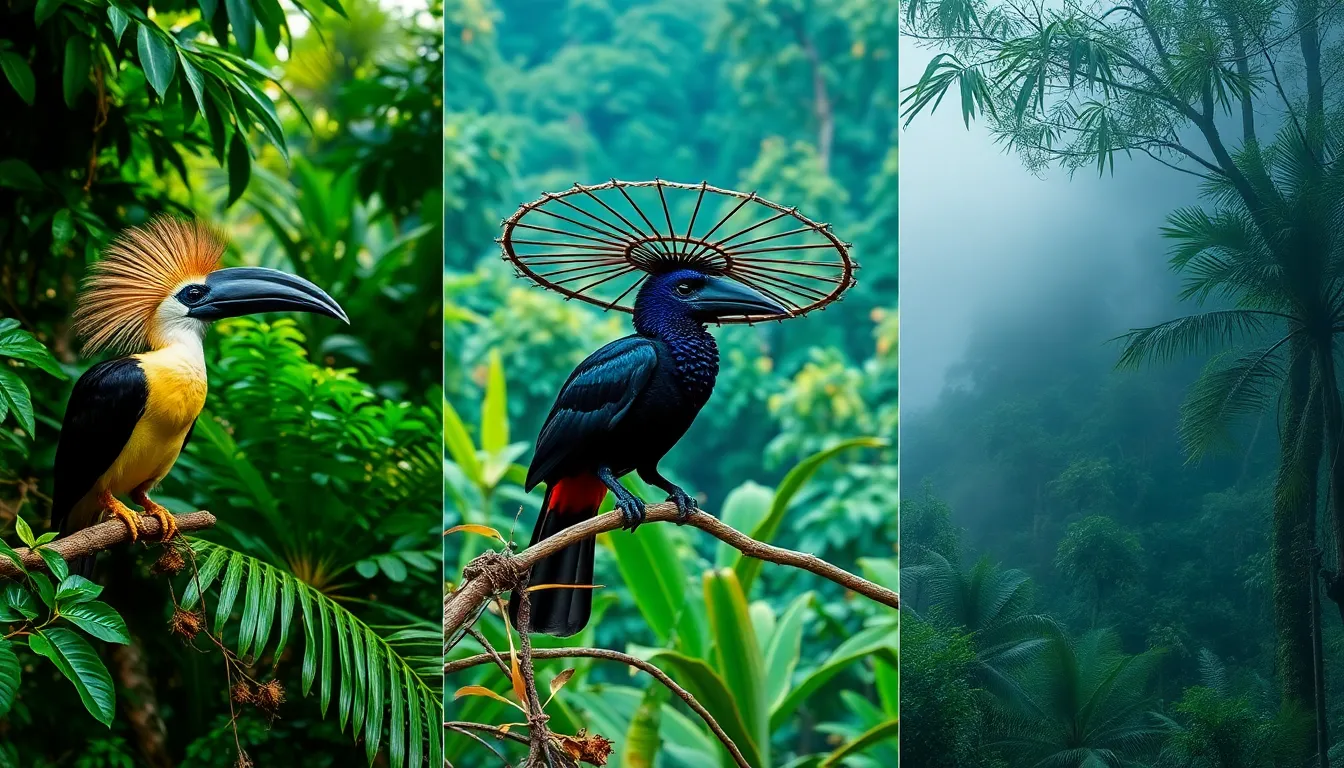
We observe three distinct umbrella bird species across the cloud forests of Central and South America. Each species displays unique characteristics while maintaining the signature umbrella shaped crest and inflatable throat sacs.
Long Wattled Umbrellabird
We find the long wattled umbrellabird (Cephalopterus penduliger) exclusively along the Pacific coast ranges of Colombia and Ecuador. Males reach lengths of 51 centimeters and weigh approximately 450 grams. The species exhibits the most pronounced sexual dimorphism among umbrella birds, with males displaying exceptionally long throat wattles that extend up to 35 centimeters during breeding displays.
Females measure significantly smaller at 36 centimeters in length and weigh around 300 grams. These birds inhabit elevations between 300 and 1,800 meters in humid montane forests. We classify this species as vulnerable due to extensive habitat destruction throughout its limited range.
Amazonian Umbrellabird
We recognize the Amazonian umbrellabird (Cephalopterus ornatus) as the largest of the three species. Males attain lengths of 50 centimeters and weights reaching 550 grams. The species ranges across the Amazon Basin, from Venezuela and Guyana south to Peru and Bolivia.
Males develop distinctive umbrella crests measuring up to 16 centimeters in diameter and throat wattles extending 28 centimeters in length. Females display more modest proportions at 42 centimeters long and 350 grams in weight. We encounter these birds primarily in lowland rainforests below 1,400 meters elevation. The species maintains stable populations due to the vast extent of suitable Amazonian habitat.
Bare Necked Umbrellabird
We identify the bare necked umbrellabird (Cephalopterus glabricollis) across Costa Rica and western Panama’s mountain forests. Males measure 41 centimeters in length and weigh approximately 320 grams. The species derives its name from the distinctive bare orange red throat patch visible on both sexes.
Males exhibit smaller throat wattles compared to other umbrella bird species, extending only 15 centimeters during displays. Females reach 35 centimeters in length and weigh around 280 grams. We observe these birds at elevations between 750 and 2,100 meters in cloud forests and forest edges. Conservation efforts focus on protecting remaining habitat corridors as deforestation threatens population connectivity across the species’ fragmented range.
Natural Habitat and Distribution
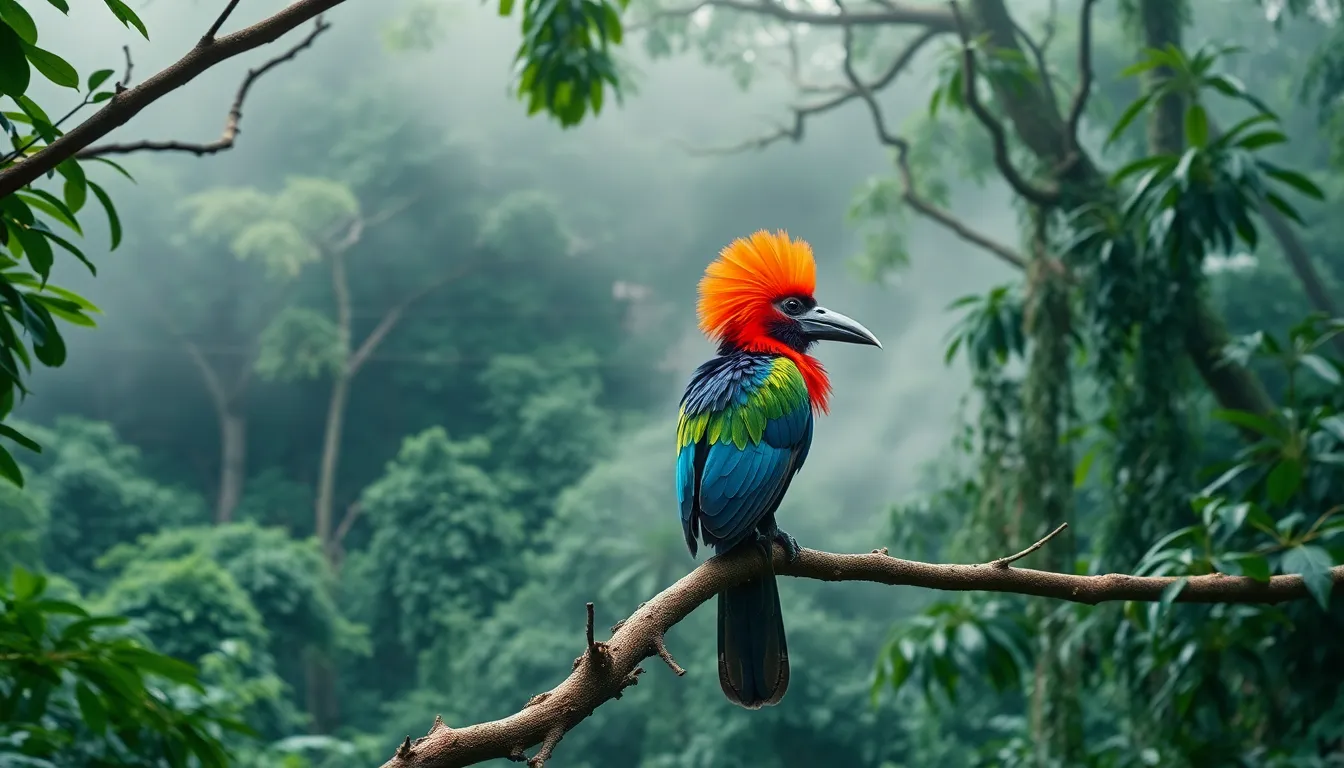
Umbrella birds inhabit the misty cloud forests and lowland rainforests of Central and South America. These magnificent cotingas occupy exact elevation ranges within their territories, adapting to the unique microclimates found in tropical mountain ecosystems.
Geographic Range
The three umbrella bird species distribute across distinct but overlapping regions of the Neotropics. Long wattled umbrellabirds occupy the Pacific coastal forests from southwestern Colombia through northwestern Ecuador, primarily between 300 and 2,100 meters elevation. Amazonian umbrellabirds range throughout the Amazon Basin, spanning Colombia, Venezuela, Ecuador, Peru, Bolivia and western Brazil in lowland areas below 1,500 meters. Bare necked umbrellabirds exist exclusively in the mountains of Costa Rica and western Panama, inhabiting elevations between 750 and 3,000 meters.
| Species | Geographic Range | Elevation Range |
|---|---|---|
| Long Wattled Umbrellabird | Pacific coast Colombia-Ecuador | 300-2,100 meters |
| Amazonian Umbrellabird | Amazon Basin (6 countries) | Below 1,500 meters |
| Bare Necked Umbrellabird | Costa Rica-western Panama | 750-3,000 meters |
Preferred Forest Environments
Cloud forests provide the ideal habitat conditions for umbrella bird populations. These ecosystems maintain constant moisture levels through persistent fog and mist, creating the humid environment essential for umbrella bird survival. Primary forest canopies offer the complex three dimensional structure umbrella birds require for nesting, feeding and territorial displays. Epiphyte laden branches provide abundant fruiting plants that comprise 80% of their diet, while large emergent trees serve as primary calling and display sites for males during breeding season. Secondary growth forests with adequate canopy connectivity also support umbrella bird populations, though at lower densities than undisturbed primary forests.
Behavior and Lifestyle
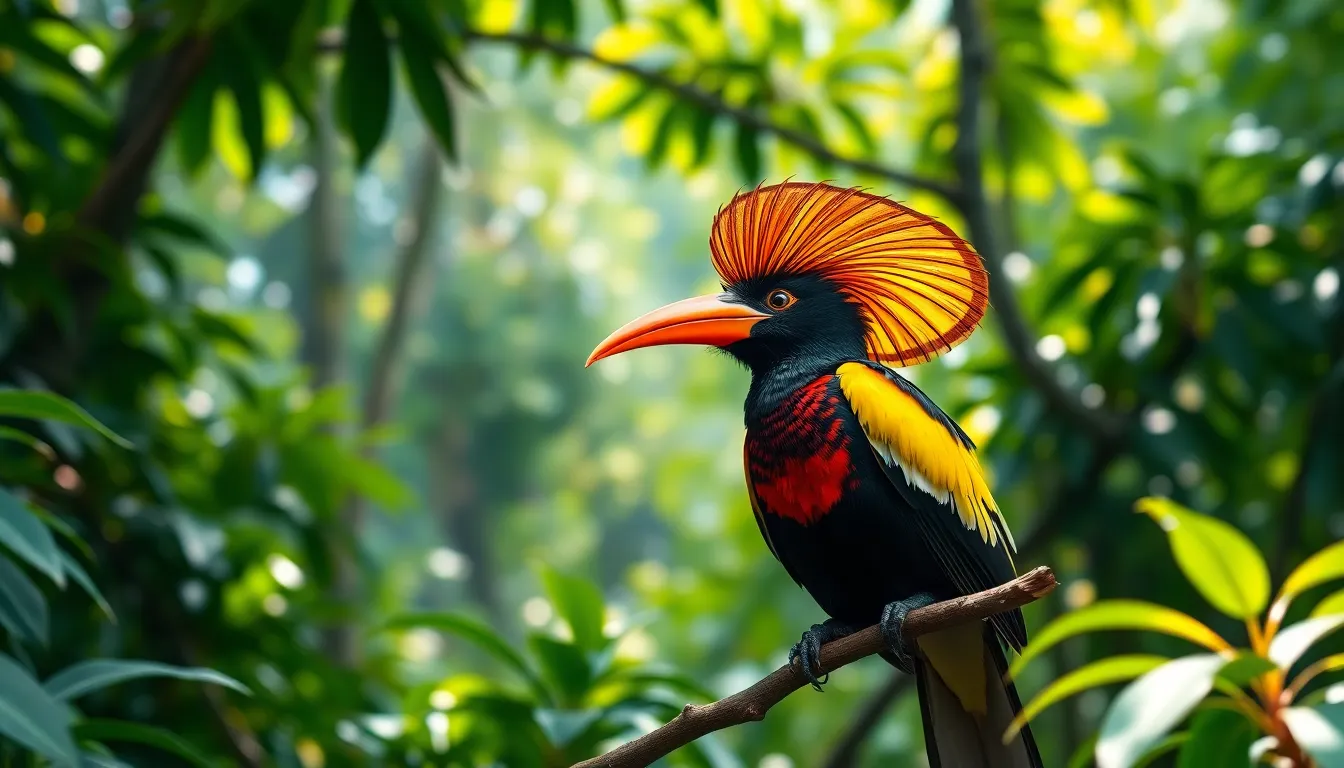
Umbrella birds exhibit fascinating behavioral patterns that reflect their adaptation to the complex cloud forest network. We observe these remarkable cotingas captivating in intricate social interactions and specialized feeding behaviors throughout their daily lives.
Mating Rituals and Courtship Displays
Male umbrella birds perform elaborate courtship displays that showcase their distinctive physical features during breeding season. We witness males inflating their throat wattles to produce deep booming calls that can travel up to 1 kilometer through dense forest canopy. Long wattled umbrellabirds display the most dramatic courtship behaviors, with males extending their inflatable throat sacs to lengths exceeding 35 centimeters while calling from prominent perches.
Amazonian umbrellabirds create lekking grounds where multiple males gather to compete for female attention through synchronized displays. Males spread their umbrella shaped crests to full extension while hopping between branches and producing rhythmic vocalizations. Bare necked umbrellabirds use their unique throat patches as visual signals, rapidly changing the coloration from dull to bright during mating displays.
Breeding pairs typically form monogamous bonds for single seasons, with females selecting mates based on the quality and intensity of male displays. We observe that successful males demonstrate consistent calling patterns and maintain prime territorial positions within the forest canopy during peak breeding months from February to June.
Diet and Feeding Habits
Umbrella birds maintain primarily frugivorous diets, consuming over 200 species of forest fruits throughout their range. We document these birds spending 60% of their active hours foraging for fleshy fruits from canopy trees including Lauraceae, Rubiaceae, and Melastomataceae families. Palm fruits constitute approximately 40% of their total diet, particularly from Oenocarpus and Euterpe species.
Foraging behavior occurs predominantly in the upper and middle canopy layers between dawn and mid morning hours. Males typically forage alone or in pairs, while females with juveniles form small feeding groups of 3 to 5 individuals. Umbrella birds swallow fruits whole and serve as crucial seed dispersers, depositing viable seeds across territories spanning up to 15 square kilometers.
Seasonal fruit availability influences umbrella bird movement patterns, with populations tracking ripening cycles of preferred food sources. We observe these birds supplementing fruit diets with insects, particularly during breeding season when protein requirements increase for egg production and chick development.
Social Structure
Umbrella birds exhibit complex social hierarchies based on territorial boundaries and breeding status. We identify dominant males maintaining territories averaging 2 to 3 hectares during breeding season, with subordinate males occupying smaller peripheral areas. Territory holders defend prime fruiting trees and calling posts through aggressive displays and physical confrontations.
Outside breeding season, umbrella birds form loose aggregations of 8 to 12 individuals around abundant food sources. Mixed species flocks occasionally include umbrella birds alongside other frugivorous species such as toucans and tanagers. Juvenile birds remain with mothers for approximately 4 to 6 months, learning foraging techniques and territorial boundaries through direct observation.
Communication patterns include over 15 distinct vocalizations ranging from soft contact calls to loud territorial announcements. We document females using exact alarm calls to warn offspring of aerial predators, while males employ different call types to establish dominance hierarchies within their communities.
Conservation Status and Threats
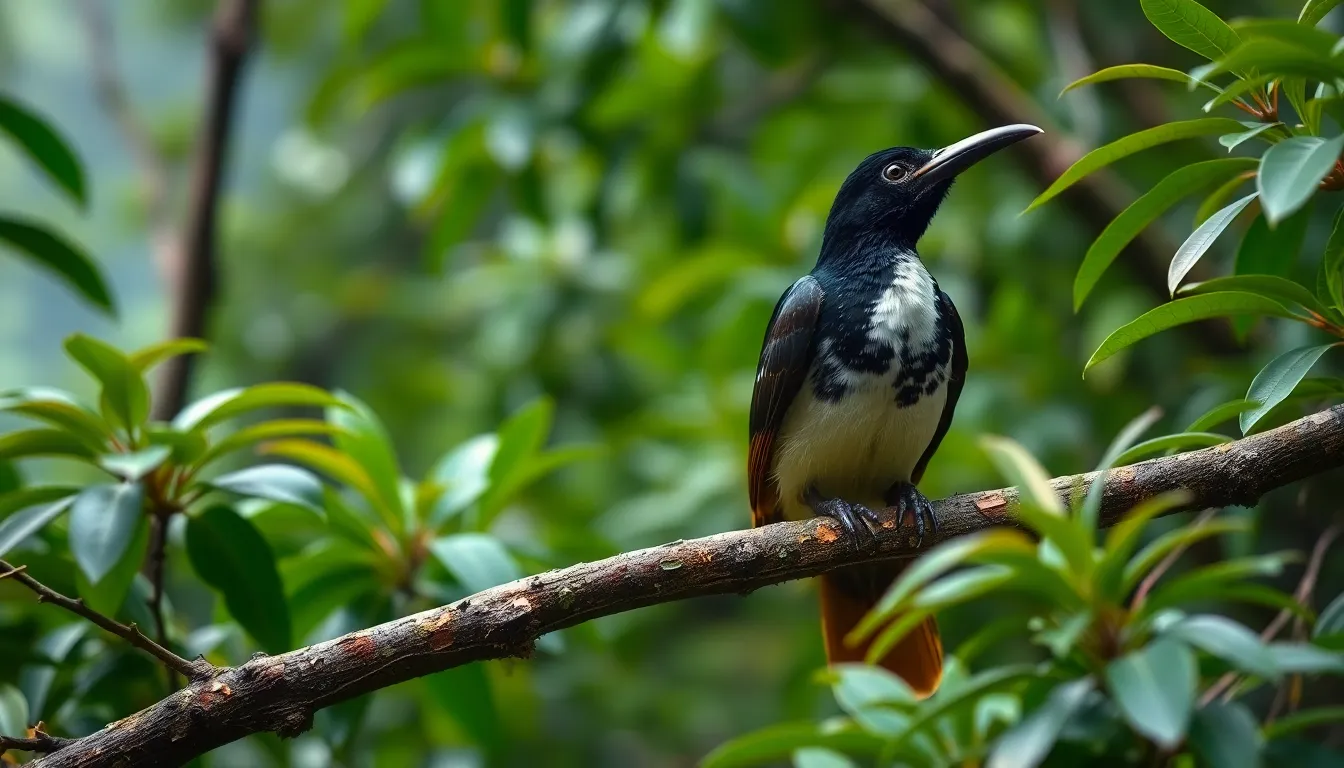
Umbrella birds face mounting pressures across their Central and South American ranges, with each species experiencing important population declines. We observe these magnificent cotingas confronting unprecedented challenges that threaten their long-term survival in cloud forest ecosystems.
Current Population Numbers
The long wattled umbrellabird currently maintains the smallest population among the three species, with fewer than 10,000 individuals remaining across Colombia and Ecuador’s Pacific coastal forests. Researchers estimate this species has experienced a 30-40% population decline over the past three decades due to extensive deforestation.
Amazonian umbrellabirds demonstrate more stable numbers throughout their vast range, with population estimates ranging between 50,000-100,000 individuals across the Amazon Basin. Brazil hosts approximately 60% of this population, while Peru, Ecuador, and Colombia support the remaining individuals in fragmented forest patches.
Bare necked umbrellabirds represent the most critically threatened species, with current estimates suggesting fewer than 5,000 individuals persist in Costa Rica and western Panama’s montane forests. This species has lost over 70% of its original habitat since 1950, resulting in isolated populations that struggle to maintain genetic diversity.
| Species | Population Estimate | Population Trend | Primary Range |
|---|---|---|---|
| Long Wattled Umbrellabird | <10,000 individuals | 30-40% decline | Colombia, Ecuador |
| Amazonian Umbrellabird | 50,000-100,000 individuals | Stable to declining | Amazon Basin |
| Bare Necked Umbrellabird | <5,000 individuals | 70% habitat loss | Costa Rica, Panama |
Environmental Challenges
Deforestation represents the primary threat to umbrella bird populations, with logging operations removing approximately 15,000 hectares of cloud forest habitat annually across their range. Agricultural expansion converts critical nesting areas into cattle ranches and palm oil plantations, fragmenting the continuous forest corridors these birds require for seasonal movements.
Climate change alters the moisture patterns essential for cloud forest ecosystems, with rising temperatures pushing optimal habitat zones to higher elevations. Umbrella birds experience reduced fruit availability as their preferred food sources shift ranges faster than the birds can adapt their territories.
Mining operations pose increasing threats to Amazonian populations, with mercury contamination affecting insect prey that umbrella birds consume during breeding season. Gold mining activities have destroyed over 2,000 hectares of prime umbrella bird habitat in Peru and Ecuador since 2015.
Human encroachment creates edge effects that penetrate up to 500 meters into intact forests, reducing the deep forest conditions umbrella birds prefer for nesting. Road construction fragments populations and increases mortality rates from vehicle strikes, particularly affecting the bare necked umbrellabird’s limited mountain habitat corridors.
Hunting pressure remains localized but important in certain regions, with indigenous communities occasionally targeting umbrella birds for their distinctive feathers used in traditional ceremonies. Pet trade captures also impact populations, though international regulations have reduced this threat substantially since 2010.
Umbrella Bird in Captivity
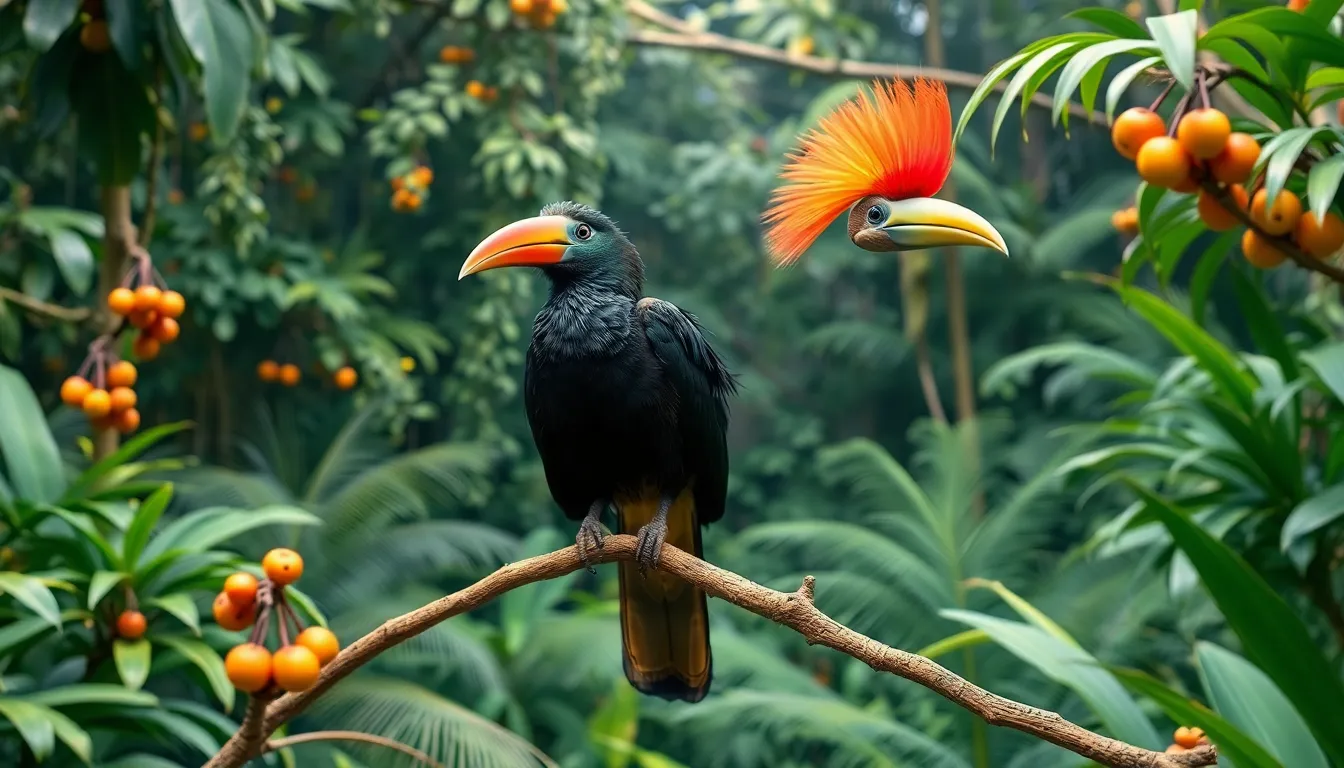
Umbrella birds present important challenges for captive care programs due to their specialized habitat requirements and complex social behaviors. Captive breeding efforts focus primarily on maintaining genetic diversity while replicating the cloud forest conditions these remarkable birds require for successful reproduction.
Zoo Breeding Programs
Zoo breeding programs for umbrella birds operate across 12 major institutions worldwide, with the most successful facilities located in Costa Rica, Ecuador, and the United States. The San Diego Zoo and La Paz Waterfall Gardens maintain the largest captive populations, housing 8 and 6 individuals respectively.
Breeding success rates remain relatively low at 35% across all participating institutions, with the bare necked umbrellabird showing the highest reproductive success in captivity. Genetic management protocols track lineages across facilities to prevent inbreeding, maintaining studbook records for over 200 individuals since program inception in 1987.
Captive breeding cycles align with natural seasonal patterns, requiring 14-16 months between successful clutches. Facilities carry out artificial rainfall systems and temperature controls to simulate cloud forest conditions, triggering natural breeding behaviors in captive pairs.
The European Endangered Species Programme coordinates international breeding efforts, facilitating genetic exchanges between North American and European facilities. Conservation breeding targets aim to maintain populations of 50 individuals per species across participating institutions.
Care Requirements
Care requirements for captive umbrella birds demand specialized environmental controls that replicate their native cloud forest habitat. Enclosures maintain humidity levels between 85-95% with temperatures ranging from 65-75°F throughout the day.
Dietary protocols include over 40 species of native fruits supplemented with high-quality protein sources during breeding seasons. Keepers provide palm fruits, figs, and berries on rotating schedules to match natural foraging patterns, offering 300-400 grams of food daily per adult bird.
Enclosure dimensions exceed 1,500 cubic feet per pair, featuring multiple canopy levels and dense vegetation to encourage natural behaviors. Facilities install misting systems that operate every 2 hours, maintaining the constant moisture levels umbrella birds require for respiratory health.
Veterinary care focuses on respiratory monitoring due to the species’ sensitivity to air quality changes and fungal infections common in high-humidity environments. Health assessments occur monthly, tracking weight fluctuations and examining throat wattles for signs of inflammation or injury.
Behavioral enrichment programs incorporate sound recordings of wild umbrella bird calls to stimulate natural vocalizations and territorial displays. Keepers rotate feeding locations and introduce novel fruiting branches weekly to encourage natural foraging behaviors and prevent stereotypic movements.
Social housing arrangements pair compatible individuals based on genetic compatibility and behavioral assessments, with backup housing available for aggressive or incompatible birds. Captive umbrella birds require visual barriers and escape routes to reduce stress levels in confined spaces.
Cultural Significance and Research
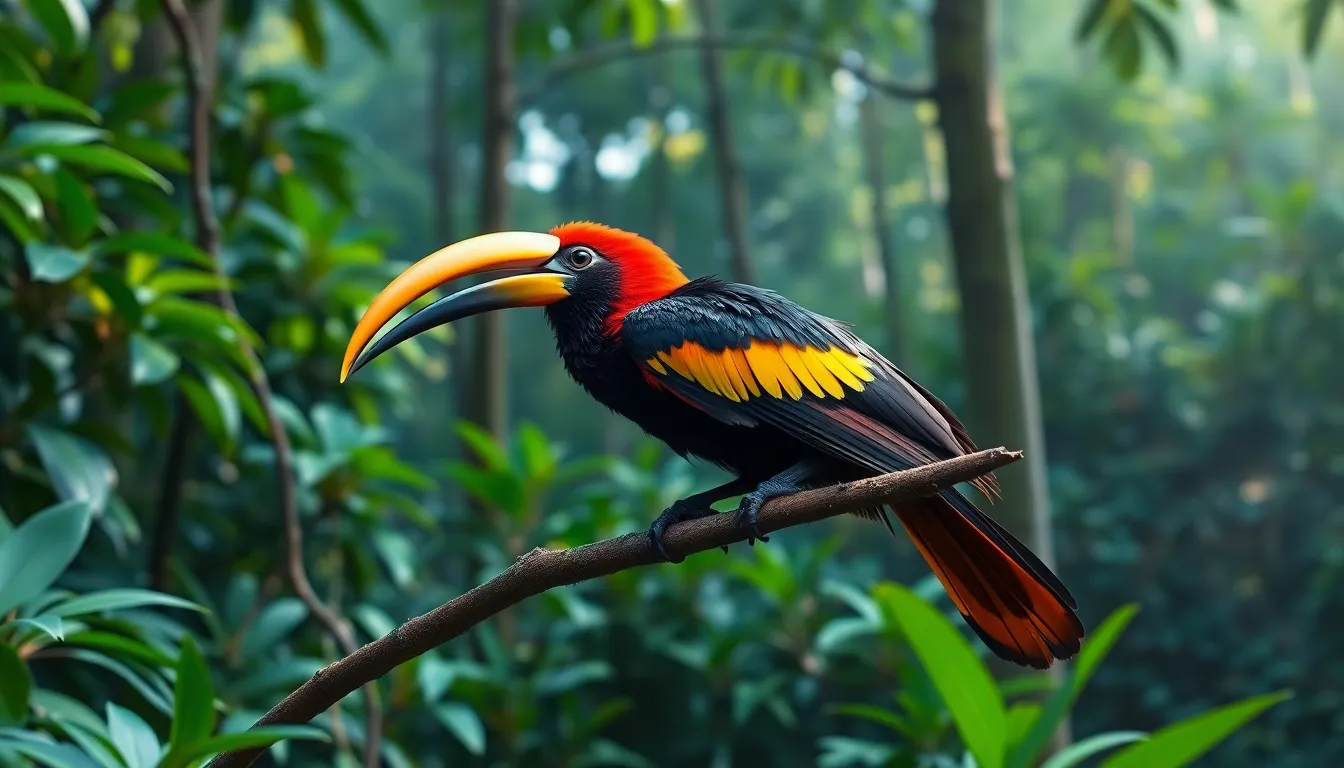
Indigenous communities throughout Central and South America have revered umbrella birds for centuries, incorporating these mysterious creatures into their spiritual beliefs and traditional folklore. The Embera people of Colombia consider the long wattled umbrellabird a messenger between the earthly and spirit worlds, while Amazonian tribes view the species’ distinctive calls as omens of seasonal changes. Local names for these birds reflect their cultural importance: “pajaro paraguas” (umbrella bird) in Spanish-speaking regions and “uirapuru preto” (black uirapuru) among Brazilian communities.
Scientific research on umbrella birds began in earnest during the 1960s when ornithologist Alexander Skutch first documented their complex mating behaviors in Costa Rica. Modern research efforts focus on three primary areas: population genetics, acoustic ecology, and habitat restoration techniques. Researchers from the Smithsonian Institution have been tracking umbrella bird populations since 1985, establishing 47 monitoring stations across their range to study migration patterns and breeding success rates.
Recent genetic studies reveal fascinating insights into umbrella bird evolution and species differentiation. DNA analysis conducted by the University of California shows that the three species diverged approximately 2.8 million years ago, with the bare necked umbrellabird being the most genetically distinct. These findings help conservation biologists understand population connectivity and inform breeding program strategies at zoological facilities.
Acoustic research has revolutionized our understanding of umbrella bird communication systems. Scientists use specialized recording equipment to capture vocalizations at frequencies as low as 20 Hz, revealing that males can adjust their calls based on forest density and atmospheric conditions. The Cornell Lab of Ornithology maintains a comprehensive database of over 3,000 umbrella bird vocalizations, enabling researchers to study regional dialects and individual recognition patterns.
| Research Focus Area | Active Studies | Key Institutions | Timeline |
|---|---|---|---|
| Population Genetics | 8 studies | UC Berkeley, Smithsonian | 2018-2025 |
| Acoustic Ecology | 12 studies | Cornell Lab, STRI | 2015-2025 |
| Habitat Restoration | 15 projects | Wildlife Conservation Society | 2020-2030 |
| Breeding Biology | 6 studies | San Diego Zoo, Fundación ProAves | 2019-2026 |
Climate change research has become increasingly important for umbrella bird conservation, with scientists studying how shifting weather patterns affect cloud forest ecosystems. Temperature monitoring stations placed throughout their habitat show average increases of 1.2°C over the past 30 years, forcing these birds to migrate to higher elevations. Researchers predict that suitable habitat could decrease by 40% within the next 50 years if current warming trends continue.
Collaborative research between international teams has produced groundbreaking discoveries about umbrella bird ecology. The Neotropical Bird Club coordinates research efforts across seven countries, facilitating data sharing and standardizing monitoring protocols. These partnerships have resulted in 127 peer reviewed publications since 2000, significantly expanding scientific knowledge about these elusive species.
Citizen science initiatives engage local communities in umbrella bird research and conservation efforts. The eBird platform has recorded over 2,400 umbrella bird sightings since 2010, providing valuable distribution data for researchers. Photography projects document behavioral changes and help identify individual birds through unique crest patterns and wattle characteristics.
Educational programs in schools throughout Costa Rica and Ecuador teach students about umbrella bird conservation, creating the next generation of environmental stewards. These initiatives combine traditional ecological knowledge from indigenous communities with modern scientific methods, fostering cultural preservation alongside species protection efforts.
Conclusion
We’ve explored the extraordinary industry of umbrella birds and their remarkable adaptations to cloud forest environments. These magnificent cotingas represent one of nature’s most unique evolutionary achievements with their distinctive crests and vocal capabilities.
The future of umbrella birds depends entirely on our collective conservation efforts. We must act swiftly to protect their remaining habitats while supporting breeding programs that maintain genetic diversity.
Our understanding of these birds continues to grow through ongoing research and community engagement. By working together with local communities and conservation organizations we can ensure that future generations will witness the spectacular displays of these remarkable forest dwellers.
The umbrella bird’s story reminds us that protecting biodiversity requires immediate action and long-term commitment to preserving the industry’s most precious ecosystems.
Frequently Asked Questions
What are umbrella birds and where are they found?
Umbrella birds are distinctive species of cotingas found in the cloud forests and rainforests of Central and South America. They’re characterized by their jet-black plumage and unique umbrella-shaped crests. These remarkable birds inhabit misty environments from Costa Rica to the Amazon Basin, with three distinct species adapted to specific geographic regions including Pacific coastal forests, Amazonian lowlands, and mountainous cloud forests.
How many species of umbrella birds exist?
There are three distinct species of umbrella birds: the Long-wattled Umbrellabird found along the Pacific coast of Colombia and Ecuador, the Amazonian Umbrellabird inhabiting the Amazon Basin, and the Bare-necked Umbrellabird located in Costa Rica and western Panama. Each species has unique characteristics and adaptations to their specific habitats, with the Amazonian species being the largest of the three.
What makes umbrella birds unique in appearance?
Umbrella birds are distinguished by their striking jet-black plumage and distinctive umbrella-shaped crests, particularly prominent in males. Males also possess inflatable throat sacs called wattles that help produce deep vocalizations. They exhibit significant sexual dimorphism, with males being considerably larger than females. Females display more subdued coloring for camouflage during nesting, while males showcase elaborate ornamental features for mating displays.
What do umbrella birds eat?
Umbrella birds are primarily frugivorous, consuming over 200 species of forest fruits throughout their range. They spend significant time foraging in the forest canopy and supplement their diet with insects, particularly during breeding season. Their feeding patterns follow seasonal fruit availability, making them important seed dispersers in their ecosystems. This specialized diet requires diverse, intact forest habitats with abundant fruiting plants.
How do umbrella birds communicate and mate?
Male umbrella birds perform elaborate courtship displays during breeding season, inflating their throat wattles to produce deep booming calls that can travel up to 1 kilometer. The Long-wattled Umbrellabird exhibits the most dramatic displays, while Amazonian species create lekking grounds for synchronized mating rituals. Breeding pairs typically form monogamous bonds, with females selecting mates based on display quality and territorial dominance.
What is the conservation status of umbrella birds?
All three umbrella bird species face significant conservation challenges. The Long-wattled Umbrellabird has fewer than 10,000 individuals remaining with a 30-40% population decline over three decades. The Bare-necked Umbrellabird is critically endangered with fewer than 5,000 individuals. The Amazonian species maintains a more stable population of 50,000-100,000 but still faces threats from habitat destruction and climate change.
What threatens umbrella bird populations?
Primary threats include deforestation, agricultural expansion, mining operations, and climate change affecting their cloud forest habitats. Localized hunting pressures also impact populations. Habitat fragmentation disrupts their movement patterns and breeding behaviors. Cloud forest destruction is particularly concerning as these specialized environments provide essential moisture levels and complex forest structure necessary for umbrella birds’ survival and reproduction.
Can umbrella birds be kept in captivity?
Umbrella birds present significant challenges in captivity due to their specialized habitat requirements and complex social behaviors. Currently, 12 major institutions maintain breeding programs with relatively low success rates. Captive care requires replicating cloud forest conditions including precise humidity and temperature controls, specialized diets, and veterinary care focused on respiratory health. Behavioral enrichment and appropriate social housing are essential for their well-being.
What role do umbrella birds play in their ecosystem?
Umbrella birds serve as vital seed dispersers in their forest ecosystems, helping maintain forest diversity through their frugivorous diet. They consume over 200 species of forest fruits and travel significant distances, spreading seeds across their territory. Their presence indicates healthy forest ecosystems, and their decline can signal environmental degradation. They also contribute to the complex food web relationships within cloud forests and rainforests.
Why are umbrella birds culturally significant?
Umbrella birds hold special reverence among indigenous communities in Central and South America, who incorporate them into spiritual beliefs and folklore. They represent the mystical nature of cloud forests and are often featured in traditional stories and cultural practices. Scientific research since the 1960s has revealed insights into their evolution, communication systems, and ecological importance, making them flagship species for conservation efforts in neotropical forests.

